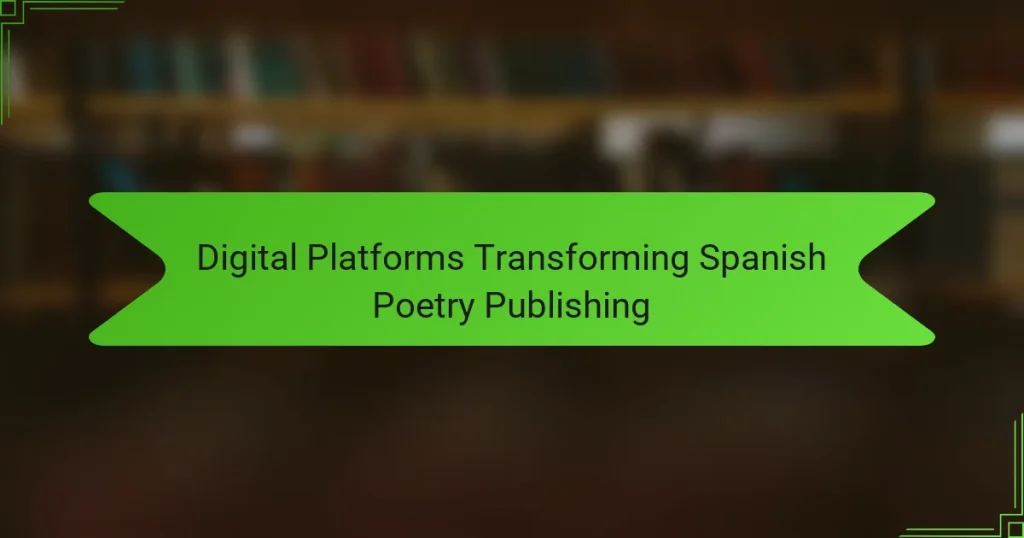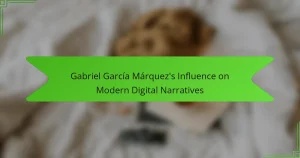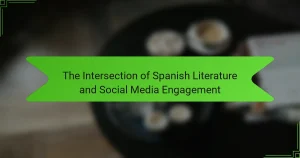Digital platforms are transforming Spanish poetry publishing by enhancing accessibility and diversifying distribution channels. Poets can self-publish and reach wider audiences without traditional gatekeepers. These platforms foster community engagement and collaboration, while also presenting challenges like market visibility and monetization. Innovative formats and real-time feedback reshape how poetry is presented and consumed, attracting younger readers and broadening the poetic landscape.
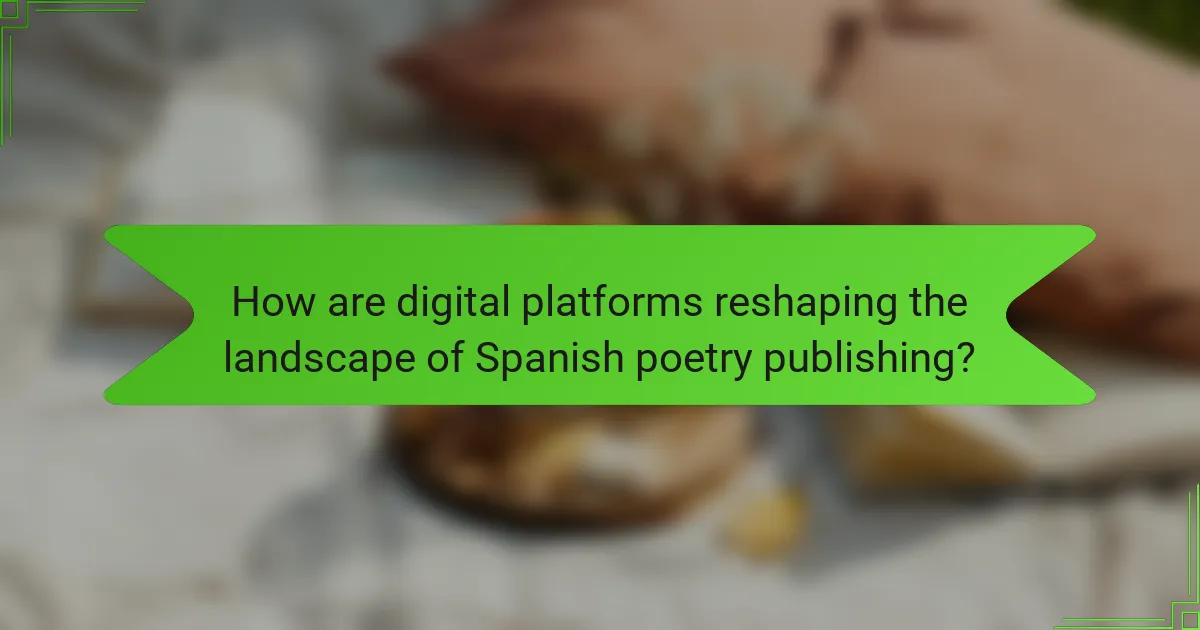
How are digital platforms reshaping the landscape of Spanish poetry publishing?
Digital platforms are revolutionising Spanish poetry publishing by increasing accessibility and diversifying distribution channels. These platforms enable poets to reach wider audiences without traditional gatekeepers. As a result, self-publishing has surged, allowing unique voices to emerge. Digital tools facilitate collaboration and community-building among poets, enhancing creative exchange. Furthermore, online formats like blogs and social media allow for innovative presentation styles, attracting younger readers. The shift to digital also introduces unique challenges, such as the need for effective marketing strategies to stand out in a crowded space.
What are the key features of digital poetry platforms?
Digital poetry platforms offer unique features that enhance the accessibility and engagement of Spanish poetry. Key features include user-friendly interfaces, interactive tools for collaboration, and multimedia integration that enriches the poetic experience. These platforms often provide community-building elements, allowing poets to connect and share their work with a broader audience. Additionally, they support diverse forms of poetry, enabling various expressions and styles to flourish in the digital space.
Which platforms are most popular among Spanish poets?
Social media platforms like Instagram and Twitter are most popular among Spanish poets for sharing their work. These platforms allow poets to reach wider audiences and engage in real-time conversations. Additionally, platforms like Wattpad and Medium provide opportunities for longer-form publishing, enabling poets to showcase their full creative range. The rise of digital platforms has transformed how Spanish poetry is distributed and consumed, fostering a vibrant online community.
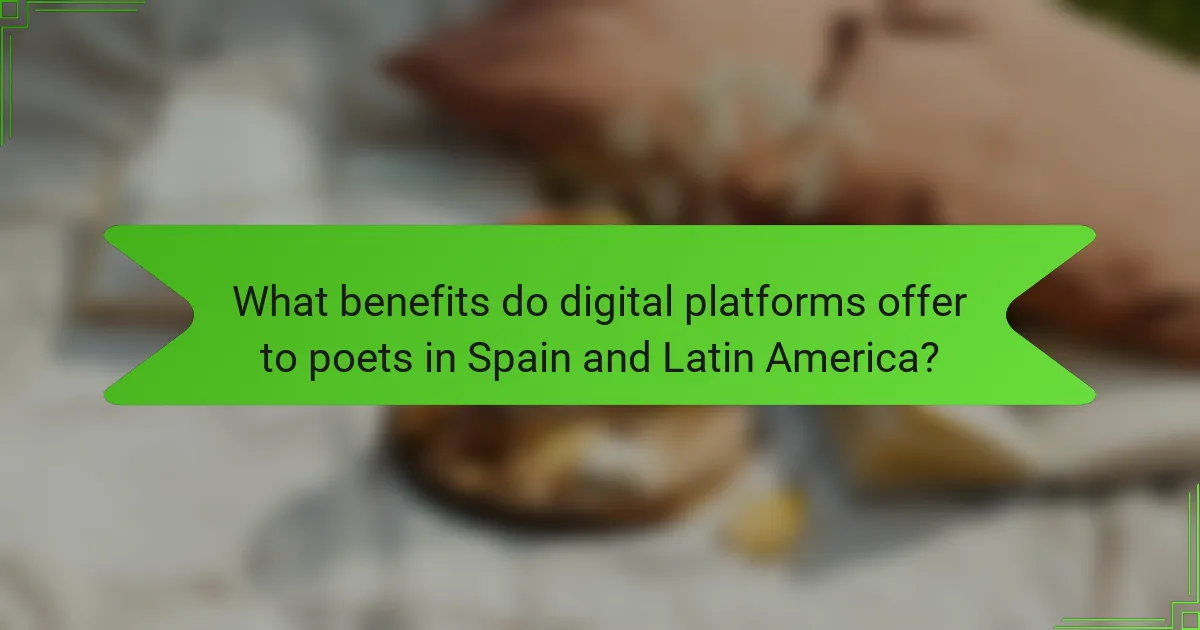
What benefits do digital platforms offer to poets in Spain and Latin America?
Digital platforms offer poets in Spain and Latin America enhanced visibility, access to diverse audiences, and opportunities for collaboration. They facilitate self-publishing, allowing poets to share their work without traditional barriers. These platforms also provide tools for engaging with readers through multimedia content, fostering community and interaction. As a result, poets can build their brand and reach global markets more effectively.
How do digital platforms enhance accessibility for emerging poets?
Digital platforms significantly enhance accessibility for emerging poets by providing broader reach and resources. They enable poets to publish work without traditional barriers, such as publishing contracts or high costs. Online communities foster collaboration and feedback, helping poets refine their craft. Additionally, platforms often offer tools for promotion, allowing poets to connect with audiences globally. This democratisation of poetry publishing empowers diverse voices, enriching the literary landscape.
In what ways do digital platforms facilitate collaboration among poets?
Digital platforms significantly enhance collaboration among poets by providing accessible tools for sharing and feedback. These platforms enable poets to connect globally, exchange ideas, and collaborate on projects in real-time. Online workshops and forums foster community engagement, allowing poets to critique each other’s work and refine their craft collectively. Additionally, social media facilitates instant dissemination of poetry, garnering wider audiences and promoting collaborative anthologies. Overall, digital platforms transform the landscape of Spanish poetry publishing by breaking geographical barriers and encouraging diverse poetic expressions.
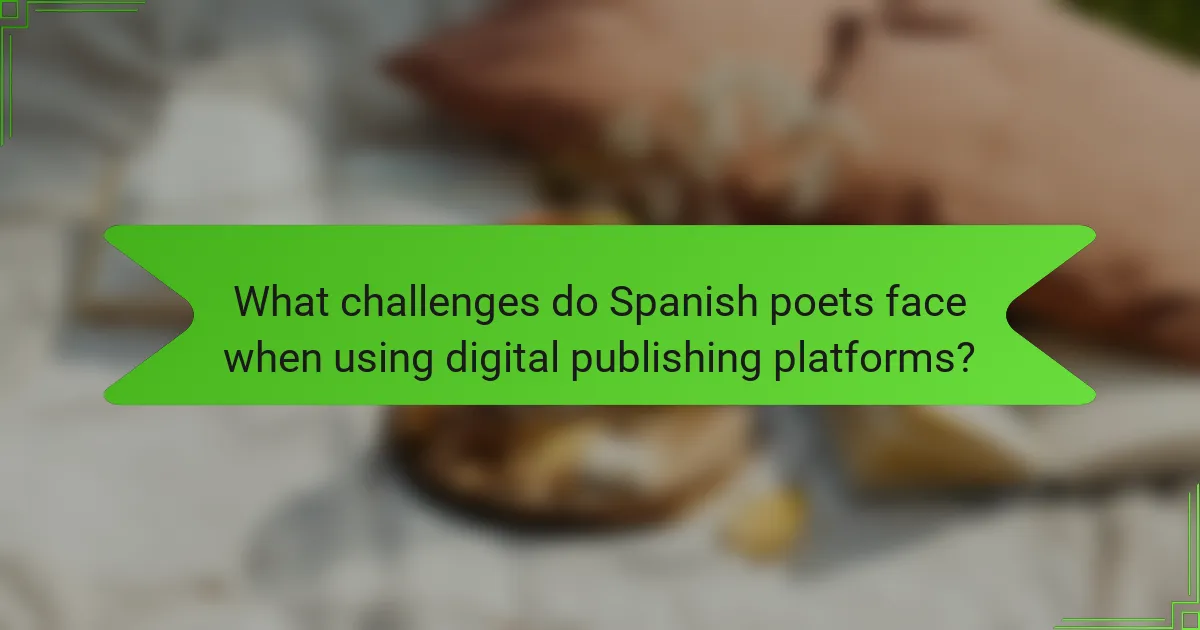
What challenges do Spanish poets face when using digital publishing platforms?
Spanish poets face several challenges when using digital publishing platforms. These include limited visibility in a crowded market, difficulties in monetising their work, and the need for technical skills to navigate these platforms effectively. Additionally, the digital landscape can dilute the traditional essence of poetry, making it harder for poets to maintain their unique voice. The rapid pace of content consumption often leads to undervaluation of their work, impacting their ability to connect with audiences meaningfully.
How do copyright issues affect poets on digital platforms?
Copyright issues significantly impact poets on digital platforms by limiting their control over their work. Many poets face challenges in protecting their intellectual property, which can lead to unauthorised use of their poetry. Digital platforms often operate under complex licensing agreements that may not favour individual creators. As a result, poets must navigate these legal landscapes carefully to maintain their rights and ensure fair compensation. The rise of social media further complicates matters, as sharing poetry can inadvertently dilute ownership.
What are common technical barriers for poets in rural areas?
Common technical barriers for poets in rural areas include limited internet access, lack of digital literacy, and inadequate exposure to publishing platforms. These obstacles hinder their ability to engage with digital platforms transforming Spanish poetry publishing. For example, unreliable internet connections restrict access to online workshops and resources. Additionally, many poets may not be familiar with the tools required for digital publishing, affecting their ability to share their work effectively.
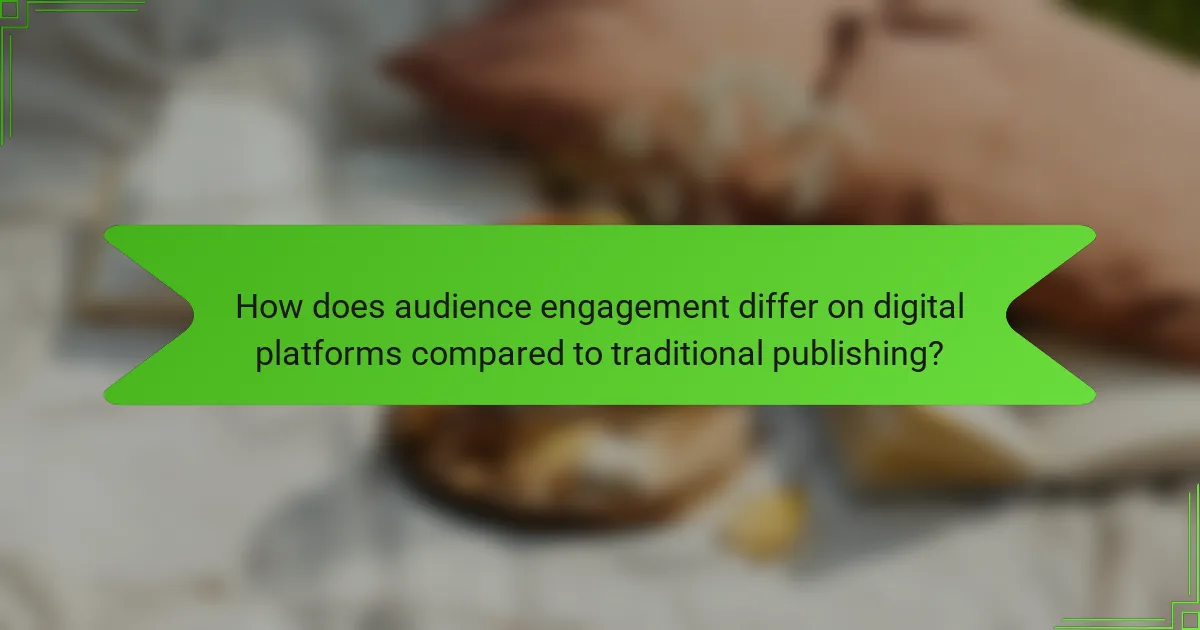
How does audience engagement differ on digital platforms compared to traditional publishing?
Digital platforms enhance audience engagement in Spanish poetry publishing through interactivity and accessibility, unlike traditional publishing. Digital formats allow for immediate feedback and community interaction, fostering deeper connections. For example, social media enables poets to share their work instantly and receive real-time responses. This level of engagement is rare in traditional publishing, which relies on delayed feedback mechanisms. Additionally, digital platforms reach a broader audience, breaking geographical barriers that limit traditional print.
Which strategies increase reader interaction with poetry online?
Engaging readers with poetry online requires innovative strategies. Utilising social media platforms fosters community and interaction through sharing and discussions. Interactive features, such as comment sections and live readings, enhance participation. Multimedia elements, like videos and audio, make poetry more accessible and engaging. Collaborative projects, such as crowd-sourced anthologies, invite reader contributions and deepen connections.
How do social media integrations impact poetry visibility?
Social media integrations significantly enhance the visibility of Spanish poetry by broadening its audience reach. Platforms like Instagram and Twitter allow poets to share their work instantly, fostering community engagement and interaction. These integrations facilitate real-time feedback and promote the discovery of emerging poets. As a result, poetry gains exposure beyond traditional publishing channels, increasing its cultural relevance. Sharing multimedia content, such as videos or audio readings, further enriches the experience, attracting diverse audiences.
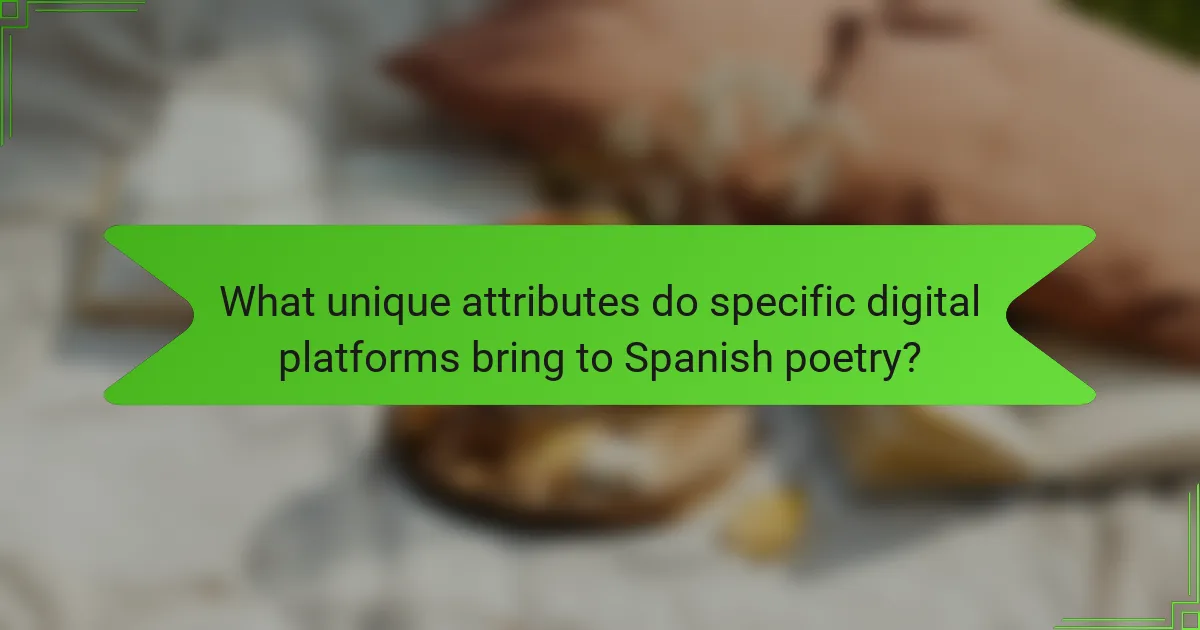
What unique attributes do specific digital platforms bring to Spanish poetry?
Digital platforms uniquely enhance Spanish poetry by offering accessibility, diverse formats, and community engagement. These platforms allow poets to reach wider audiences through social media, blogs, and digital publishing. Unique attributes include real-time feedback from readers, multimedia integration, and opportunities for collaboration. For instance, platforms like Instagram and YouTube enable poets to share performances, enhancing the poetic experience. Additionally, digital anthologies provide a space for emerging voices, fostering a vibrant community.
How do user-generated content features influence poetic expression?
User-generated content features significantly enhance poetic expression by fostering collaboration and accessibility. Digital platforms allow poets to share their work widely, receive immediate feedback, and engage with diverse audiences. This interaction can inspire new themes and styles, enriching the poetic landscape. Moreover, the ability to remix and adapt existing works encourages innovation, leading to unique poetic forms. As a result, user-generated content acts as a catalyst for creativity in Spanish poetry publishing.
What role do multimedia elements play in enhancing poetry on digital platforms?
Multimedia elements significantly enhance poetry on digital platforms by creating immersive experiences. They engage audiences through visual art, audio readings, and interactive features, deepening emotional connections. This integration allows poets to express unique attributes of their work, such as rhythm and tone, which are often lost in traditional formats. As a result, digital platforms transform how Spanish poetry is consumed, reaching broader audiences and enriching the literary landscape.
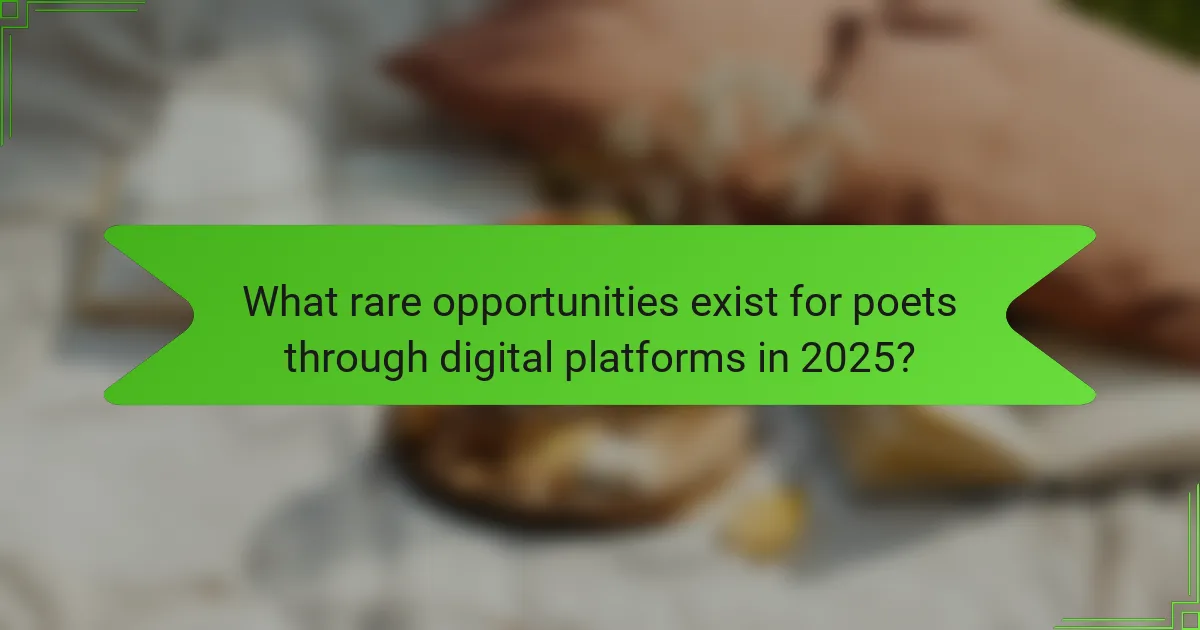
What rare opportunities exist for poets through digital platforms in 2025?
Digital platforms will provide poets in 2025 with unique opportunities for wider audience engagement, collaboration, and innovative publishing methods. Social media and digital anthologies will allow for real-time feedback and community building. Emerging technologies like AI will enable personalised poetry experiences, enhancing reader interaction. Additionally, blockchain may offer new revenue models through digital rights management, ensuring poets receive fair compensation.
How are digital platforms fostering international collaborations in poetry?
Digital platforms are enhancing international collaborations in poetry by providing accessible venues for poets to share their work globally. These platforms facilitate cross-cultural exchanges, allowing poets from different backgrounds to connect and collaborate on projects.
Online workshops and virtual readings enable poets to engage with audiences worldwide, fostering a sense of community. Digital tools like social media and collaborative writing apps promote the sharing of diverse poetic forms and styles, enriching the global poetry landscape.
Moreover, platforms like blogs and literary websites offer opportunities for multilingual publishing, making Spanish poetry accessible to non-Spanish speakers. This inclusivity broadens the audience and encourages translations, further enhancing international collaboration.
In summary, digital platforms are critical in transforming Spanish poetry publishing by fostering connections, promoting inclusivity, and facilitating collaborative efforts across borders.
What innovative formats are emerging in digital poetry publishing?
Innovative formats in digital poetry publishing include interactive websites, multimedia poetry apps, and social media platforms. These formats enhance reader engagement and allow for dynamic expression. For instance, interactive websites can feature animations and audio, creating immersive experiences. Multimedia apps enable poets to combine text, sound, and visuals seamlessly. Social media platforms facilitate immediate feedback and community interaction, fostering collaboration among poets and readers. These emerging formats transform how Spanish poetry is shared and experienced in the digital landscape.
What expert tips can help poets maximize their impact on digital platforms?
To maximize their impact on digital platforms, poets should focus on engaging their audience through authentic storytelling and consistent content creation. Building a strong online presence involves sharing work across multiple platforms, utilising social media for direct interaction, and participating in virtual poetry events.
Leveraging multimedia elements, such as videos and audio recordings, can enhance the accessibility and appeal of poetry. Collaborating with other artists and influencers can also expand reach and introduce poetry to new audiences.
Regularly analysing engagement metrics helps poets refine their strategies, ensuring their work resonates with followers. By embracing these tactics, poets can effectively navigate the evolving landscape of digital poetry publishing.
